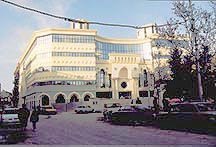|

Winter
1998 (6.4)
Pages
24-28
The Metamorphosis
of Architecture
and Urban Development in Azerbaijan
by Pirouz Khanlou
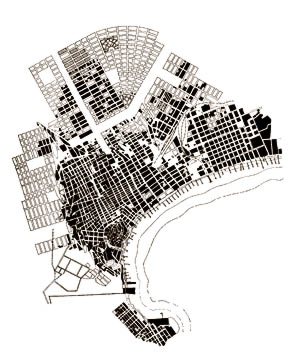  The
state of architecture in Azerbaijan today is one of dramatic
change and transition. Here architect Pirouz Khanlou describes
the path that architecture has taken throughout this past century
and where it is headed. The purpose of this article is not to
elaborate the history of Azerbaijan's architecture, but rather
to discuss its transformation and define some of its current
needs and problems. The
state of architecture in Azerbaijan today is one of dramatic
change and transition. Here architect Pirouz Khanlou describes
the path that architecture has taken throughout this past century
and where it is headed. The purpose of this article is not to
elaborate the history of Azerbaijan's architecture, but rather
to discuss its transformation and define some of its current
needs and problems.
How do you embrace
the future without discarding the past? This question brings
to mind the figure of the Roman god Janus, an astute personage
who is always pictured with two faces, looking forward and backward
at the same time. The month of January was named after this god
because he was identified with beginnings. Newly independent
countries like Azerbaijan need to adopt both profiles just like
Janus, as they look ahead to the prospect of the future while
at the same time not forgetting their past. The question is how
to transition to a free market economy while remaining integrated
within the cultural and historical framework of the past.
As an architect, I wonder how Azerbaijan will face the future
and its challenges and yet protect its own rich cultural and
architectural heritage. For instance, will it be able to preserve
the exotic medieval Inner City (Ichari Shahar) and Baku's 19th-
and early 20th-century center, which fuse a variety of European
styles (Neo-classical, German and Italian Renaissance Revival,
French Gothic, Art Nouveau) with Eastern styles (Safavid, Persian,
Cairo, Ottoman and Magrebi)?
Being the capital city, it is Baku that becomes the model for
the rest of Azerbaijan. Baku is perhaps the only true Eurasian
city on the world map, not only geographically but in its unique
ability to synthesize both European and Asian architectural styles
which are indicative of the mental synthesis that has taken place
in cultural and social realms as well. This uniqueness must be
maintained and fostered.

|
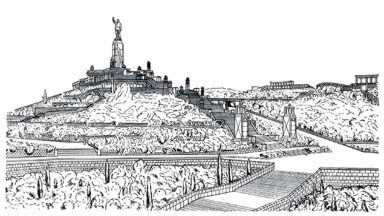
|
Left: The residence of the Sadigov Brothers
is one of many eclectic buildings based on an eclectic style
in central Baku. Here a French Islamic Magrebi style presents
an interesting design solution for a corner building. Architect:
Ter Mikelov (1911).
Right: Perspective of Kirov Monument at Baku's
summit (1951). It resembles an ambitious Stalinist Fascist architecture
with its grandiose scale overlooking the city. Kirov's statue
was pulled down when Azerbaijan gained its independence (1991).
Architect: L. Elin. |
Oil Boom
The turn-of-the-century Oil Boom triggered a "Big Bang"
in the architectural history of Baku. Before this time, Baku
had been only a sleepy little town that did not play a major
role in the region, especially compared to Tabriz (now Iran),
Tbilisi (now Georgia) and Istanbul (Turkey). Beginning in the
1880s, however, hundreds of new buildings and residences were
constructed, each more extravagant than the next, as Oil Barons
competed with one another to see who could create the most spectacular
building.
By the early 1900s, Baku had become a fully developed, sophisticated
metropolitan center in the Caucasus. Based on a well-planned
urban design, its municipal infrastructure included parks, streets,
public transportation, along with a safe water supply, sewage
and railway systems. There were numerous public buildings such
as schools, hospitals, opera and drama theaters, government buildings,
mosques and cathedrals. Perhaps most noteworthy were the elegant
private residences built by the oil barons. Baku's existing downtown
is a brilliant manifestation of this period. The industrial district
on the north side of Baku, familiarly known as "Black City"
(Gara Shahar), was characterized by the state-of-the-art petroleum
industry of its time, and included industrial buildings, refineries,
exploration facilities, a related manufacturing and transportation
system as well as housing for the workers.
The Oil Boom, based on private ownership and entrepreneurship,
came to a screeching halt when the Bolsheviks toppled the Democratic
Republic of Azerbaijan and took over Baku (April 1920). Thus
began a completely new era in the history of the country, affecting
every aspect of political, economic and social life, including
architecture. The luxurious residences of the oil barons and
other industrialists were seized and all personal belongings
were confiscated. Except for the grandest of buildings, mansions
were partitioned into apartments and assigned to numerous families.
The glory of the past was reduced to "communal dwellings."
Left: General view of industrial
developmentBalakhani in the "Black City" of Baku
of early 20th century.
Right: Yesterday's dream (1963): a socialist
mass housing development in Micro Region No. 1, Baku. Today's
reality: poorly maintained apartment complexes. Ganjlik region,
Baku.
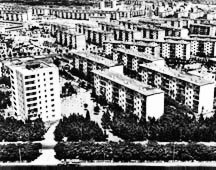 |
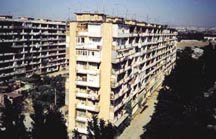 |
Soviet Planning
The
decade between 1920 and 1930 could be called the "Decade
of Transition". Russian intellectuals and the avant-garde
were excited about the Socialist Revolution and were in search
of a New Soviet Man and a socialist society. Naturally, these
mainstream revolutionary movements influenced the new Soviet
Republic of Azerbaijan. At this time, New Economic Planning (NEP)
was implemented. City planning was organized primarily by Moscow,
and local architects and urban planners were influenced by Modernists
such as Le Corubsier (projects like "unit d'habitation")
and especially Constructivists like Moises Ginsburg.
Between the 1930s and mid-1950s, Baku, like many other Soviet
cities, was given a Master Plan. This period can be categorized
as the Stalinist period, during which large-scale buildings of
solid quality and construction were erected. Many public buildings
and infrastructure projects were undertaken at this time such
as the Ministries building and numerous apartment buildings.
Many of these housing projects were based on typical socialist
planning in which the massing was organized around communal gardens.
Between the late 1950s and the mid-1980s, there was a special
emphasis on housing. Many large-scale housing projects were completed
in Baku and other Azerbaijani cities. They were characterized
by central socialist urban planning under the concept of "Ideal
Communist City Planning." Micro-regions (suburbia) and satellite
cities such as Sumgayit were built in Baku's outer limits. In
general, this period is marked by large-scale mass housing projects,
wide avenues, standardization of building design and construction
method and the introduction of prefabricated construction elements.
These projects reflect the era in which they were designed and
constructed-such as the Stalin, Khrushchev and Brezhnev periods.
Left: Azerbaijan International Bank and ISR
Plaza adjacent Fountain Square which have just been completed.
Right: An example of poor eclectic design
which has no relevance to its context in downtown Baku. Caricature
of Persian architecture.
  Collapse Collapse
From
the early 1980s until the collapse of the Soviet Union in late
1991, the Soviet bureaucracy, crippled by an economy that was
nearly bankrupt, proved incapable of continuing its ambitious
city planning and urban development projects. Tragically, it
could not even maintain its existing buildings and aging infrastructure.
Photo: New development in the "Inner
City" behind a medieval courtyard.
A primary reason for this collapse was that Soviet technology
had become hopelessly outdated. The West, spurred to sudden growth
by developments in the computer industry, went through what amounted
to a second industrial revolution, whereas the Soviet Union fell
behind. Soviet products could no longer compete on the world
market because they were built with technology from the 1970s.
Huge Azerbaijani factories such as the ones in Sumgayit became
good for nothing more than scrap metal.
The Perestroika and Glasnost phases of the Gorbachev era played
an important role in opening up the Soviet Union to the outside
world. In September 1990, the SSR Azerbaijan hosted the First
Azerbaijani Business Congress in Baku, attracting several hundred
business representatives, companies and entrepreneurs from all
over the world. For the first time since the collapse of the
Democratic Republic of Azerbaijan (1920), this marked an independent
effort by Azerbaijanis to connect to the outside world. It is
interesting to look back now and realize that many of these same
businessmen have returned to Azerbaijan to initiate new projects
and bring foreign investment to the country.
 |
 |
Left: Azerbaijan
Press House influenced by Constructivist architecture style.by
S. Pen (1934).
Right: Constructivist design
proposal for a cultural center in the Bailov region. Architect:
L. Vesnins (1937). |
New Momentum
In 1994
with the signing of the "Contract of the Century,"
as Azerbaijanis dub the contract with AIOC, a new stage of development
for Azerbaijani business began. As Western oil companies began
to establish offices in Baku, there was an urgent need for modern
strategic service industries such as telecommunications, transportation,
banking, insurance and hotels. It became crucial to make the
country "business-able." Since late 1995, many major
commercial and residential construction projects have been initiated.
Some have already been completed, while others are still under
construction. This renewed development is somewhat reminiscent
of the Oil Boom of the late 1800s-after nearly 80 years, a new
energy is being pumped into the architectural development of
the country.
For the most
part, construction and development has been so rapid that legislation
has not been able to keep pace, especially in terms of municipal
ordinances such as city zoning and building codes (regulations),
and the establishment of various architectural commissions and
other appropriate governing bodies. The Soviet regulations of
the past no longer apply or fulfill the needs of the present
day, and new laws have yet to take their place. There are no
systematic rules and regulations that apply to modern construction
technology or fulfill present needs for contemporary building
and development.
Right now with the new privatization, rules and regulations are
interpreted individually. To prevent this, Baku city needs to
have a working plan-checking system, clear zoning definitions
and a building inspection system that is fairly and correctly
implemented.
This is a determining moment in Azerbaijan's history. So many
changes are going on that the transformation seems quite overwhelming.
Baku was not designed to handle this much growth. At the same
time, it cannot inhibit growth, nor should it. It is time to
deal seriously with these issues so that Baku's appearance will
be protected and the health, environment, safety and well-being
of its entire population will be guaranteed.
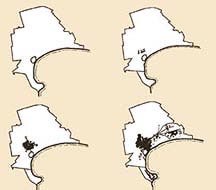 |
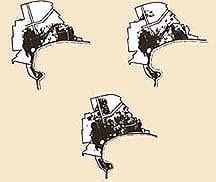 |
Baku in 1806. 1822. 1854. 1878 |
1898. 1918. After 1918 |
A Master Plan
Baku
needs a revised Master Plan. The most recent one was introduced
in 1984 after 12 years of deliberation. It was supposed to be
completed by 2005, but quickly became outdated in 1991 when Azerbaijan
began its path from a centralized state economy to a market economy.
An independent country with a new governmental structure and
a new privatized market economy requires a service sector, including
banking, insurance, transportation, shipping, airports, terminals,
business and commercial projects, housing and mixed-use developments.
This infrastructure requires many new buildings: hotels and restaurants
for the tourism industry, shopping centers, business centers,
communication centers, sports facilities, conference centers,
etc.
A new Master Plan must address the needs of a market-based society,
especially needs created by economic and population growth. For
example, in Baku there are still no guidelines in place regarding
parking requirements in new buildings, not even high rise buildings.
The concept of parking inside a building is still so new that
one city building official recently told a foreign developer
that it was dangerous for cars to be parked in garages underneath
the building! With the recent multiplication of cars in Baku,
traffic and parking is already an issue, and will soon become
a more serious problem.
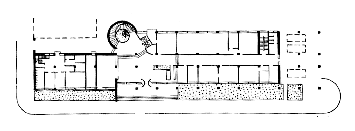  Petroleum
office building influenced by the modern movement (1952). Petroleum
office building influenced by the modern movement (1952).
Internal Refugees
The tragic displacement of nearly one million internal refugees
due to Armenia's occupation of close to 20 percent of Azerbaijan's
territory has exacerbated the situation. Baku alone has seen
an influx of 200,000 to 300,000 refugees, stretching the city's
infrastructure beyond its capability. Ten years ago, the population
of Baku was less than 1.5 million; today it is closer to 2 million.
In addition to the fact that these people need jobs, the strain
on public services is unprecedented.
Nearly every
section of the city, some more frequently than others, has to
cope with the sudden interruption of utilities, whether it be
water, gas or electricity. This is the norm rather than the exception.
There are immense plumbing problems as faucets run and cannot
be shut off. The city's sewage system was not built to handle
its present load. Streets are in disrepair and filled with treacherous
potholes. Telephones are still far from adequate, even though
immense improvement has taken place since 1995.
  Left: General view of industrial development - Balakhani
in the "Black City" of Baku of early 20th century. Left: General view of industrial development - Balakhani
in the "Black City" of Baku of early 20th century.
Zoning
Well-thought-out
zoning codes need to be studied and implemented so that they
will regulate commercial, high-density and low-density residential
areas as well as hospitals, schools and agricultural areas in
an appropriate manner. For example, in the Inner City, office
buildings and companies have already invaded a historic residential
area.
Building Codes
Well-developed, modern building codes and regulations need to
be implemented along with a fair but strict inspection system.
Currently, there is no systematic plan-checking protocol that
guarantees that building codes and regulations are followed before
a building permit is issued. Outdated Soviet-era building codes
don't take into account appropriate building safety requirements
or new kinds of construction technology.
Transportation
Baku
needs a safe, reliable transportation system that incorporates
public transportation such as the Metro, tram and bus systems
as well as private vehicles. In 1995, the worst Metro accident
in world history took place in Baku when a fire broke out in
a subway car during rush hour. More than 300 people lost their
lives in the nightmarish scenario that followed, as passengers
were trapped and suffocated in the train cars. Other aspects
of the city's public transportation system are also in desperate
need of repair. Buses are dilapidated and need maintenance. Tram
cables often slip off of their electric wires, resulting in traffic
jams and delays. These systems need to be studied and updated
and put on regular maintenance programs.
Traffic
Traffic
patterns need to be studied and systematized. Baku was planned
during the Soviet period when private ownership of cars was rare.
Most people relied upon public transportation, as ownership of
cars was restricted to government officials and extremely privileged
Party members. These days, however, cars are widely available.
During the past five years, the private use of cars in Baku has
increased at least twenty-fold. Consequently, the desperately
outdated traffic system does not work anymore.
For example, there is no system for making left turns or U-turns
in the city. Instead, one has to drive to a roundabout that may
be miles away. Most city streets are based on a one-way system,
but not in a consistent, predictable pattern of alternating streets.
There is an enormous amount of redundant traffic movement, which
results in street congestion, pollution, wear and tear on the
streets and vehicles as well as waste of fuel-not to mention
the amount of time that is lost. This is especially true in central
Baku and the Inner City.
Historical Buildings
Azerbaijanis
also need to have a better understanding of the architectural
structure of their historical buildings. In many old buildings,
columns are three feet or more in diameter. There have been occasions
when contractors thought that they could hack away at the outside
of the column to decrease its size, not realizing that the strength
of the column is in its outer concrete rim, not in the center,
which is usually filled with loose debris and rubble. Such ignorance
can cause entire buildings to collapse. Not long ago, a column
in one old building was removed, causing the entire building
to collapse into tons of debris.
Conservation
Conservation
and renovation regulations should be passed and strictly enforced;
otherwise, the beauty and uniqueness of many of Baku's older
buildings will be at risk. Of course, this threat is nothing
new, as the Soviets were notorious for dividing beautiful mansions
into numerous one- and two-room apartments, giving residents
no choice but to share kitchen and bathroom facilities.
Inner City (Ichari
Shahar)
The
development going on in the Inner City should be re-examined.
The narrow lanes and alleys of the Inner City were primarily
designed for pedestrian use. In a few places, camel caravans
and horses could navigate the area. Now, because of a lack of
zoning regulations, nearly a dozen international companies have
moved their offices inside the 12th-century citadel walls, simply
because management was intrigued by the exotic location. As a
result, there are frequent traffic jams.
First, the Inner City should be preserved to maintain the pulse
of the vibrant residential community that has lived there for
many generations. Large corporate offices should not be allowed
in the central part of town. Second, the outer edges of the Inner
City should be developed to attract tourists with gift shops,
restaurants and other sites. Of course, there are many gray areas
when it comes to conserving buildings. Inevitably change will
and should result simply because building materials are different
today from what they were 100 years ago.
Training of Architects
Today's
architects, planners and engineers need to be trained for the
future. Azerbaijanis are at an extreme disadvantage, as their
knowledge has become obsolete. Examples such as the unfinished
Baku airport (Bina) and the old Moscow and Karabakh hotels illustrate
that local architects don't understand the basic principles of
airport and hotel design.
Architects need to be retrained. Exposure to the outside world
is essential. Architecture schools in Azerbaijan would benefit
tremendously from new curricula, architecture books and journals,
exchange programs, seminars, visiting professors and relationships
with international institutes. Students need exposure to architecture
in other countries, which of course means traveling there. Architects
also need to have exposure to the latest concepts set forth in
international architectural books and journals.
Personal Responsibility
So far,
I've discussed issues that must be implemented on a governmental
level. Now I would like to mention the necessity of adopting
a new mental attitude. With personal ownership comes the necessity
of personal responsibility. In the past, Azerbaijanis took care
of the interiors of their apartments, assuming that the government
would maintain the exterior. In other words, they compartmentalized
ownership between the individual and the state. If something
belonged to the state, they ignored it, or even abused it. This
kind of mentality has to change.
In a market-based
society, communities come together to make decisions about how
their environment should look and be maintained. Azerbaijanis
are still struggling with this concept. For even a simple decision
like maintaining a public stairwell in an apartment building,
neighbors are still floundering, not knowing how to organize
themselves to agree upon a plan of action. Individuals must learn
to participate in the decision-making process, and not just assume
that someone else will take responsibility for the things that
need to be done.
Mechanisms need
to be created to incorporate input from the community into the
existing environment. In this way, systems can correct themselves,
and development can move ahead. Problems that we can't anticipate
today will be handled wisely and in due course if there is a
systematic framework for addressing them.
From Azerbaijan
International
(6.4) Winter 1998.
© Azerbaijan International 1998. All rights reserved.
Back to Index
AI 6.4 (Winter 1998)
AI Home
| Magazine
Choice | Topics
| Store
| Contact
us
|







